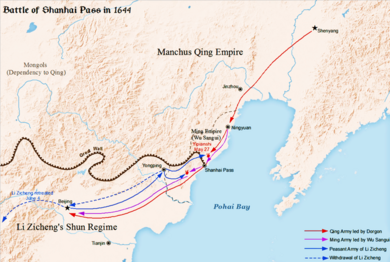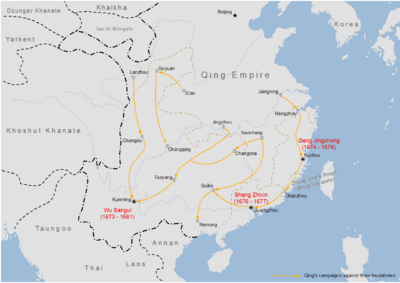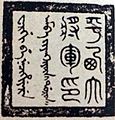Wu Sangui facts for kids
Quick facts for kids Wu Sangui |
|||||||||||||||||
|---|---|---|---|---|---|---|---|---|---|---|---|---|---|---|---|---|---|
 |
|||||||||||||||||
| Emperor of the Zhou dynasty | |||||||||||||||||
| Reign | March 1678 – 2 October 1678 | ||||||||||||||||
| Successor | Wu Shifan | ||||||||||||||||
| King of Zhou (周王) | |||||||||||||||||
| Reign | 1673–1678 | ||||||||||||||||
| Prince Who Pacifies the West (平西王) | |||||||||||||||||
| Reign | 1644–1673 | ||||||||||||||||
| Born | 8 June 1612 Gaoyou, South Zhili, Ming dynasty |
||||||||||||||||
| Died | 2 October 1678 (aged 66) Hengyang, Hunan, Qing dynasty |
||||||||||||||||
| Consorts | Empress Zhang Chen Yuanyuan |
||||||||||||||||
|
|||||||||||||||||
| House | House of Wu | ||||||||||||||||
| Dynasty | Zhou dynasty | ||||||||||||||||
| Father | Wu Xiang | ||||||||||||||||
| Mother | Lady Zu | ||||||||||||||||
| Wu Sangui | |||||||||||||||||||
|---|---|---|---|---|---|---|---|---|---|---|---|---|---|---|---|---|---|---|---|
| Traditional Chinese | 吳三桂 | ||||||||||||||||||
| Simplified Chinese | 吴三桂 | ||||||||||||||||||
|
|||||||||||||||||||
Wu Sangui (Chinese: 吳三桂; pinyin: Wú Sānguì; Wade–Giles: Wu San-kuei; 8 June 1612 – 2 October 1678) was a famous military leader in China. He lived during a time when the Ming dynasty was falling and the Qing dynasty was beginning. Many people in China remember him as a controversial figure who played a big part in major historical events.
In 1644, after his father, a Ming general, was killed, Wu Sangui made a deal with the Manchu invaders. He opened the gates of Shanhaiguan, a key pass, allowing the Manchus to enter China. This helped them create the Qing dynasty in Beijing. For his help, the Qing rulers gave him control over the Yunnan and Guizhou provinces and a special title: "Prince Who Pacifies the West."
Later, in 1674, Wu Sangui decided to rebel against the Qing dynasty he had helped create. In 1678, he declared himself the new Emperor of China and ruler of a new Zhou dynasty. However, he died just a few months later. His grandson, Wu Shifan, took over, but the Kangxi Emperor of the Qing Dynasty eventually stopped the rebellion.
Contents
Wu Sangui's Early Life and Training
Wu Sangui was born in Gaoyou, a city in southeastern China. His parents were Wu Xiang and Lady Zu. His father and uncle were both military generals who fought in many battles. Because of this, Wu Sangui grew up around war and politics, and he became very interested in them.
When he was young, Wu Sangui studied with a famous artist named Dong Qichang. This education helped him become smart and resourceful.
In 1627, at just 15 years old, Wu became a military scholar. He and his two brothers joined the army. They served as generals, protecting important areas like the Daling River and Ningyuan.
In 1630, Wu Sangui's father, Wu Xiang, was surrounded by many Qing soldiers. Wu Sangui, even without much help, bravely led about 20 of his own soldiers to rescue his father. They surprised the Qing army, and Wu Sangui saved his father. Both the Qing leader Hong Taiji and Wu's uncle, Zu Dashou, were impressed by his courage. Wu Sangui became a guerrilla general before he was 20.
Serving the Ming Dynasty
Protecting Liaodong
In 1632, Wu Sangui, at 22, was transferred to Shandong province to fight rebel armies. He fought alongside his father and quickly rose through the ranks, becoming a full general.
By 1639, the situation in Liaodong was very tense. The Ming court put General Hong Chengchou in charge, and Hong appointed Wu Sangui to train troops.
Later that year, a Qing army attacked Ningyuan. The general there was killed, and Wu Sangui took his place. He became a guardian general for Liaodong. Wu Sangui made his local army the strongest in Liaodong, with 20,000 soldiers. He even created a special group of 1,000 elite soldiers, who were his personal bodyguards. These soldiers were key to his future military success.
Important Battles and Challenges
In 1640, Wu Sangui fought the Qing army at Xingshan. Even though his army was surrounded, he fought bravely. He managed to break through the siege with help, but his army suffered many losses. Still, his courage was recognized.
The Battle of Songjin began in April 1641. Wu Sangui led the Ming army and personally fought, defeating the Qing cavalry. He was seen as the most outstanding general in this battle.
However, in August 1641, the Ming army faced a major defeat. During a retreat, some generals fled, and Wu Sangui also left the battle. This led to many Ming soldiers being killed. Wu Sangui survived by choosing a different escape route, which impressed the Qing leader Hong Taiji. Hong Taiji saw Wu Sangui as a key person for conquering China.
Despite his escape, Wu Sangui was surprisingly promoted by the Chongzhen Emperor. This decision puzzled many officials, but Wu continued to serve as a governor general in Ningyuan.
Wu Sangui Joins the Qing Dynasty
Why Wu Sangui Switched Sides
By 1642, the Ming Dynasty was losing many important cities to the Manchu army. Ningyuan, where Wu Sangui was stationed, became Beijing's last defense. The Qing leaders tried many times to get Wu to surrender, but he refused.
The Ming Dynasty became very weak when a rebel army led by Li Zicheng attacked. In early 1644, Li Zicheng marched towards Beijing. The Chongzhen Emperor asked Wu Sangui to defend the capital. Wu Sangui was on his way to Beijing with his 40,000 soldiers, the strongest Ming army in the north. But then he heard that Beijing had fallen to Li Zicheng and the emperor had died.
So, Wu Sangui and his army stopped at Shanhai Pass, a key part of the Great Wall of China. He was now stuck between Li Zicheng's rebels inside the Wall and the Manchus outside.
After the Ming Dynasty fell, Wu Sangui's army was very important. Both the Manchu leader Dorgon and the rebel leader Li Zicheng wanted his support. Li Zicheng tried to get Wu to surrender by offering him rewards and capturing Wu's father.
At first, Wu Sangui thought about joining Li Zicheng. But when he heard about Li's army causing trouble and his father being held captive, he changed his mind. He killed Li's messenger and pretended to break ties with his father. He knew his army alone couldn't defeat Li Zicheng. So, he asked Dorgon, the Manchu prince-regent, for military help.
Dorgon saw this as a chance for the Qing to take control of China. He agreed to help Wu, but only if Wu submitted to the Qing. Wu Sangui eventually agreed because he had little choice. On May 22, 1644, Wu Sangui opened the gates of Shanhai Pass, letting the Qing forces into China. His soldiers wore white cloths to tell them apart from Li Zicheng's army. Together, Wu's army and the Qing forces defeated Li Zicheng's rebels in the Battle of Shanhai Pass. The Qing then marched into Beijing and made the young Shunzhi Emperor the new ruler. Wu Sangui promised his loyalty to the Qing dynasty.
Fighting Rebels in Shanxi
Wu Sangui became the "Prince Who Pacifies the West" under the Qing dynasty. However, he worried that the Qing still didn't fully trust him.
In October 1644, Wu was ordered to fight the rebel peasant army. Li Zicheng still controlled many areas and was trying to rebuild his forces. Wu Sangui, along with other generals, fought against the rebels in Shanxi. He was very successful.
Li Zicheng was angry at Wu Sangui for changing sides. He ordered the killing of 38 members of Wu's family, including his father, whose head was displayed on a city wall. This made Wu Sangui even more determined to fight Li Zicheng. Wu Sangui captured important cities, and Li Zicheng was eventually killed.
In 1645, the Qing court gave Wu Sangui a higher title, "Prince of the Blood," and told him to guard Jinzhou. But Jinzhou was no longer a militarily important place. Wu felt upset because he was being moved to a less important area. He asked to give up his new title, which was granted. He then worked to make his army stronger, and the Qing court gave him more troops and resources.
Suppressing Rebellions in Sichuan
By 1648, many former Han Chinese generals who had surrendered to the Qing began to rebel. This made the Qing rulers realize how important these generals were for controlling China. They decided to use a strategy of "using Han to rule Han." This situation helped Wu Sangui become important again.
Wu Sangui was ordered to move his family west and guard Hanzhong. In less than a year, he put down rebellions in Shanxi and improved the situation in the northwest. He proved his loyalty to the Qing dynasty by leading his troops bravely in every battle. After four years, peace returned to Shaanxi province, and Wu's status grew.
In 1652, the Daxi rebel army became a major threat to the Qing. Wu Sangui was called to fight them in Sichuan. He was closely watched by a Qing general, but after a few years, he was able to gain more freedom. He quickly made his army stronger by getting many enemy soldiers to surrender.
Controlling Yunnan Province
In 1660, the Qing army defeated the Southern Ming Dynasty, bringing most of mainland China under Qing control. However, the Yongli Emperor of the Southern Ming and the Daxi army still had influence in Yunnan. It was hard for the Qing's main army to stay in the far-off Yunnan-Guizhou border area. So, the Qing court decided to let Wu Sangui and his army take command of this area. This gave Wu a large army and control over a huge territory.
By 1661, Wu's army had 60,000 soldiers, much larger than other allied armies. He planned to stay in Yunnan permanently and make it his own. Yunnan was not stable, with many local leaders refusing Wu's rule. The Yongli Emperor and his army were also a threat. Wu wanted to eliminate them to strengthen his control. He exaggerated the dangers of the rebellion and convinced the Qing court to invade Burma, where the Yongli Emperor had fled.
In June 1662, the Yongli Emperor was captured and killed. In the following years, Wu Sangui led his army to secure Qing control over the southwest border region.
Wu Sangui's Rebellion
After defeating the remaining Ming forces, Wu Sangui was rewarded with the title "Prince Who Pacifies the West" and control over Yunnan. It was very rare for someone not from the imperial family, especially a non-Manchu, to be given such a high title. These "vassal kings" were often not trusted by the emperors.
By the end of 1662, Wu also controlled Guizhou province. His son, Wu Yingxiong, even married Princess Jianning, who was the Kangxi Emperor's aunt.
The Qing court didn't fully trust Wu, but they let him rule Yunnan with little interference. This was because the Manchus, who were a minority, needed time to figure out how to rule the vast Han Chinese society. Wu, as a semi-independent ruler in the distant southwest, was seen as useful. He received large amounts of money from the government each year. Wu used this money and the stable period to build up his army, preparing for a possible conflict with the Qing.
Wu in Yunnan, along with Shang Kexi in Guangdong and Geng Jingzhong in Fujian, became a financial burden on the central government. Their almost independent control of large areas threatened the Qing dynasty's stability. The Kangxi Emperor decided to make Wu and the other two princes move from their lands to Manchuria. In 1673, Shang Kexi asked to retire, and the Kangxi Emperor quickly agreed. Wu and Geng Jingzhong then made the same request, and the Kangxi Emperor granted it, deciding to end the three vassal states.
Feeling threatened, the three princes rebelled. This started the eight-year-long civil war known as the Revolt of the Three Feudatories. On December 28, 1673, Wu Sangui killed the governor of Yunnan and rebelled, claiming to be fighting "against the alien and rebuilding Ming dynasty." On January 7, 1674, 62-year-old Wu led his troops from Yunnan and took control of Guizhou province without any losses. Wu Yingxiong and his sons were killed by the Kangxi Emperor after Wu Sangui's rebellion began. Soon after, Wu Sangui started his own Zhou dynasty. By April 1674, his army quickly occupied Hunan, Hubei, Sichuan, and Guangxi. Over the next two years, other generals also rebelled, and Wu's rebellion grew into the larger Revolt of the Three Feudatories. By April 1676, the rebels controlled 11 provinces. For a while, it seemed like Wu might win.
However, Wu Sangui stopped his march south of the Yangzi River for three months due to a lack of troops and money. This gave the Kangxi Emperor time to gather his forces. Other rebel leaders eventually surrendered to the Qing.
In 1678, Wu Sangui went further and declared himself the emperor of the "Great Zhou" dynasty. He set up his capital in Hengzhou (modern-day Hengyang). He died in October 1678. His grandson, Wu Shifan, took over command of his forces and continued the fight. However, the remaining rebel armies were defeated in December 1681, and Wu Shifan took his own life.
The Zhou Dynasty (1678–1681)
|
Great Zhou
大周
|
|||||||||
|---|---|---|---|---|---|---|---|---|---|
| 1678–1681 | |||||||||
| Capital | Hengzhou → Kunming | ||||||||
| Common languages | Chinese | ||||||||
| Religion | Buddhism, Taoism, Confucianism, Chinese folk religion | ||||||||
| Government | Monarchy | ||||||||
| Emperor | |||||||||
|
• 1678
|
Wu Sangui | ||||||||
|
• 1678–1681
|
Wu Shifan | ||||||||
| History | |||||||||
|
• Established
|
1678 | ||||||||
|
• Disestablished
|
1681 | ||||||||
| Currency | Chinese coin, Chinese cash | ||||||||
|
|||||||||
| Today part of | China | ||||||||
| Important Leaders | |||
| Temple names | Family name and first name | Time as Ruler | Era name |
|---|---|---|---|
| Taizu | Wú Sānguì | March 1678 – October 2, 1678 | Zhāowǔ |
| Wú Shìfán | 1678–1681 | Hónghuà | |
Wu Sangui's Family
- Brothers:
- Wu Sanfeng (吳三鳳)
- Wu Sanfu (吳三輔)
- Wu Sanmei (吳三枚)
- Wives and Children:
- Empress Zhang (皇后 張氏, 1615 – 1699)
- Wu Yingxiong (吳應熊), his first son
- Concubine Chen (妾陳氏), also known as Yuanyuan (圓圓)
- Other children:
- 6 daughters
- Adopted son: Wu Yingqi
- Empress Zhang (皇后 張氏, 1615 – 1699)
What Wu Sangui Looked Like
Historians from the late Ming dynasty described Wu Sangui as a brave and good-looking general. He was of medium height, with pale skin, a straight nose, and large ears. He had a noticeable scar on his nose. He wasn't especially muscular or strong-looking. However, from a young age, he showed great courage and physical strength. He was also very skilled at horse-riding and archery.
Images for kids
See also
 In Spanish: Wu Sangui para niños
In Spanish: Wu Sangui para niños
- Ming–Qing transition
- Royal and noble ranks of the Qing dynasty
Sources
- Hummel, Arthur W. Sr., ed. (1943). "Wu San-kuei". Eminent Chinese of the Ch'ing Period. United States Government Printing Office.





